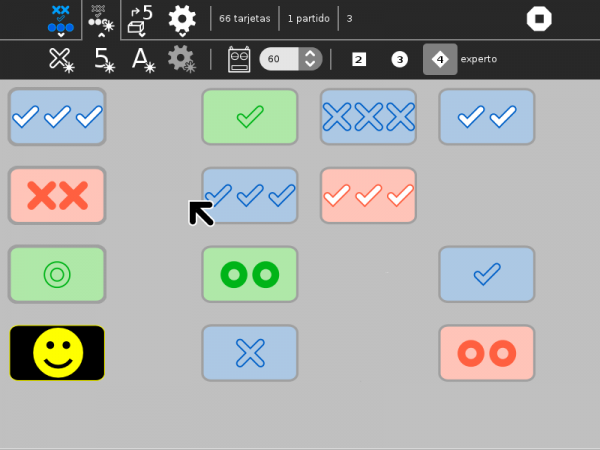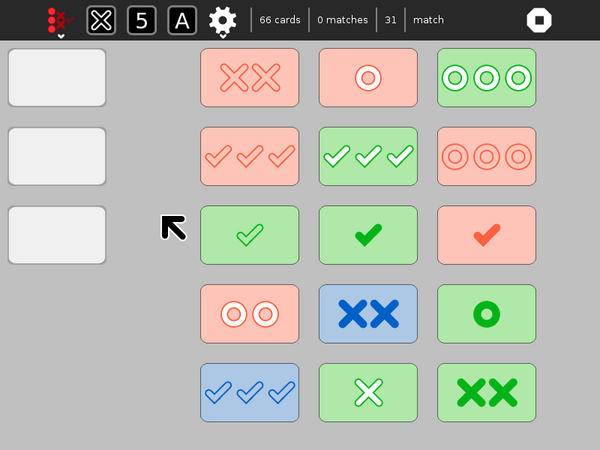Difference between revisions of "Activities/VisualMatch"
| Line 113: | Line 113: | ||
File:Visualmatch-numbers1.png|Prime factors (1,2,3,5,7 and 11) are used to determine matches | File:Visualmatch-numbers1.png|Prime factors (1,2,3,5,7 and 11) are used to determine matches | ||
File::isualmatch-numbers2.png|There are a variety of representations used in the number-match game. | File::isualmatch-numbers2.png|There are a variety of representations used in the number-match game. | ||
| − | File:Visualmatch-numbers3.png | + | File:Visualmatch-numbers3.png|Roman numerals and dots in a circle |
| − | File:Visualmatch-numbers4.png | + | File:Visualmatch-numbers4.png|Chinese and points on a star |
File:Visualmatch-words1.png|semantic word groups (animal, food, celestial objects) are used to determine matches | File:Visualmatch-words1.png|semantic word groups (animal, food, celestial objects) are used to determine matches | ||
File:Visualmatch-level-1.png|beginner mode (color, number, and shape) | File:Visualmatch-level-1.png|beginner mode (color, number, and shape) | ||
Revision as of 15:56, 3 January 2010
The basics
How to play:
- 12 cards are on the playing surface at any time.
- Click on three cards to make a match.
- The most recent match is displayed on the left.
About Visual Match
Visual Match is a pattern-matching game written for Sugar; it is included as part of the Honey collection of Sugar add-ons. The object of the game is to find sets of three cards where each attribute—color, shape, number of elements, and shading—either match on all three cards or are different on all three cards. The current version doesn't yet support sharing with multiple players or saving to the Journal, but it can be played by a single player.
i18n
Visual Match has not yet been translated into any languages other than English.
(See our Pootle server for details about how to translate Visual Match into your language.)
More details
Cards have four different attributes: color, shape, fill texture, and number of elements.
- The number version works with prime factors instead of shapes and textures.
- The word version works with semantic groupings.
Play by clicking on three cards to make a group. If it is a valid group, it will be moved on the left (in the blank-card zone.) It will be repaced by new cards from the deck.
A valid group is defined by cards where each attribrute is either the same on each card or different on each card, e.g, all three red cards or one red, one green, and one blue card.
An invalid group is when two cards share and attribute and the third card does not, e.g., one red and two green cards.
Groups must be valid across all four attributes. Examples of valid and invalid groups are shown below.
Note:
- The grid layout is arbitrary; there is no need to pick in rows or columns, or one from each column.
- The blank cards on the left are a place to display the most recnt match; they can be otherwise ignored.
Watch out, because VisualMatch can be very addictive.
Examples of valid matches


 colors, shapes, and shade match; numbers are different
colors, shapes, and shade match; numbers are different


 numbers match; colors, shapes and shade are different
numbers match; colors, shapes and shade are different
Examples of invalid matches
When there is no match
On occasion, there is no match. If there is no match, three additional cards are dealt as illustrated in the figure above.
The toolbars
From left to right:
- (a) The standard Sugar 'activity' button used to access the activity menu, which includes sharing (the latter not yet implemented);
- (b) The 'new pattern game' button used to start a new pattern game;
- (c) The 'new number game' button used to start a new number game;
- (d) The 'new word game' button used to start a new word game;
- (e) The toolbar used to access the computer assistant and the number-game variants
- (f) The number of cards remaining in the deck is displayed;
- (g) The number of matches found is displayed;
- (h) The number of seconds that have elapsed since the last match was found is displayed;
- (i) The current status is displayed; Once all of the matches have been found, the total elapsed time is displayed. Note that there may be some cards left on the playing field at the end of the game that do not make a match.
- (j) The 'stop' button is used to exit the activity.
From left to right:
- (a) The level button switches between beginner (Level 1) and expert (Level 2) modes;
- (b) The robot button is used to turn on/off computer assistance;
- (c) The time (in seconds) before computer assistance starts;
Number card options:
- products, Roman numerals, words, Chinese, hash marks, dots in circles, points on a star, dice, dots in rows
From left to right:
- (a) Sugar Activity title;
- (b) Sharing button (not yet enabled);
- (c) Sugar Keep button;
- (d) Journal-entry update button.
Note: In older versions of Sugar, these buttons appear under the 'Project' tab.
New features
As of Version 9, Visual Match includes number-search and word-search games in addition to the pattern-search game.
Note: Prior to Version 9, you needed to click the "+3" button for extra cards to be dealt when there are no matches on the board.
As of Version 14 there is a "robot" that will help you find matches. It operates on a timer—finding matches after an adjustable number of seconds. The robot is enabled/disabled by clicking on the button the the Tool menu.
As of Version 15 there are two levels of play: beginner mode and expert mode. In beginner mode, there are only 27 cards and only three card characteristics.
Show me the code
You can explore the Visual Match source code [cloning the project] directly from git.























